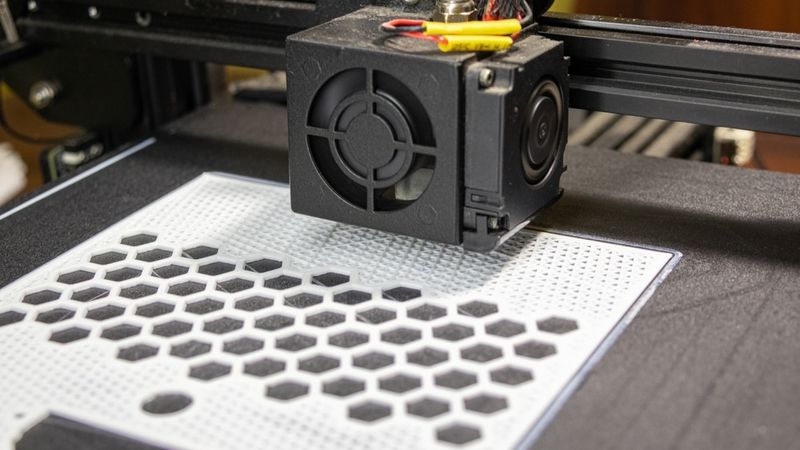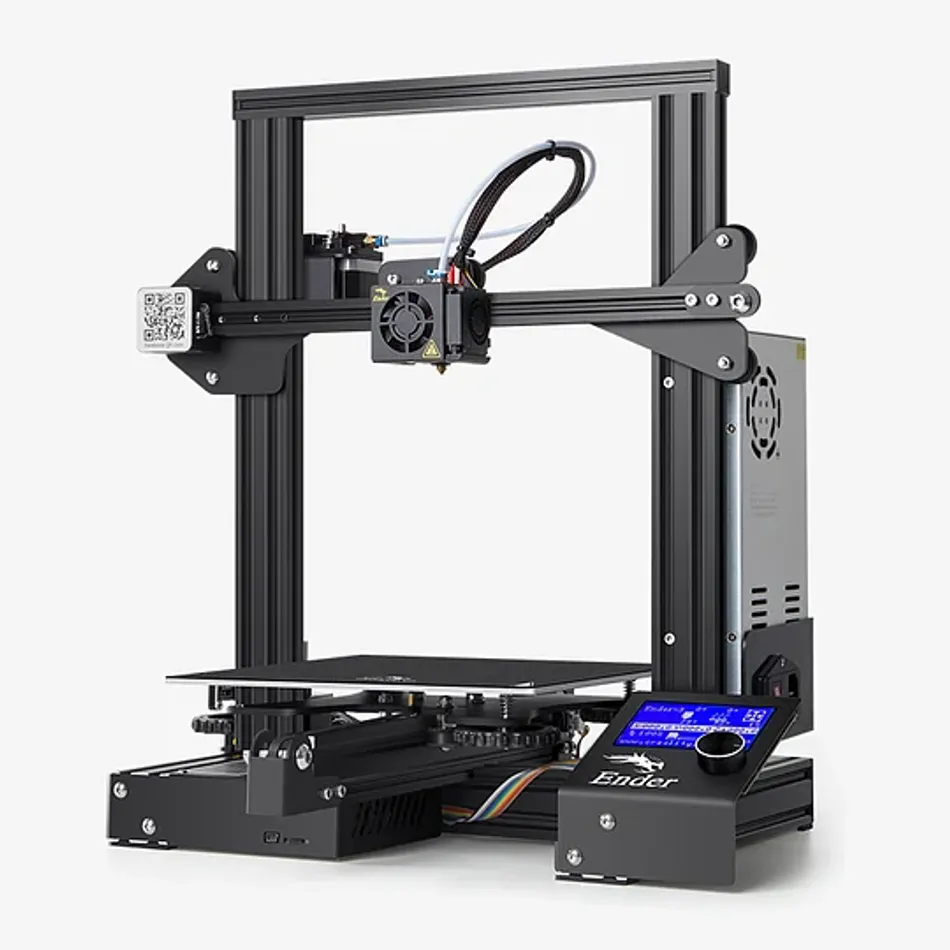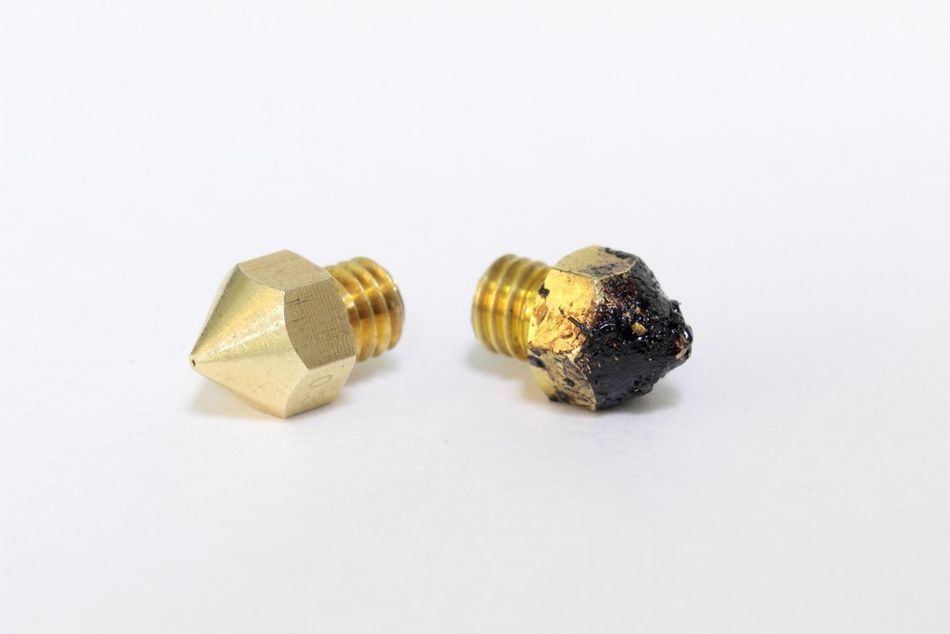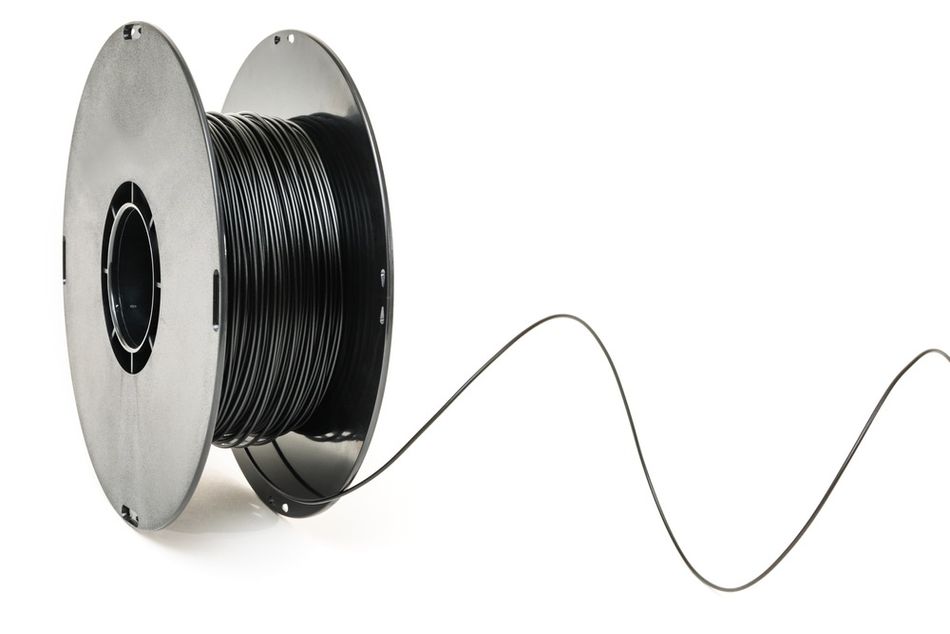Ender 3 (V2,Pro) Extruder Skipping: Ender 3 not Extruding?
Here’s what to do if you notice clicking noises, under-extrusion, or other print quality issues caused by extruder skipping on the Ender 3 by Creality.

Here's how to address extruder skipping on the Creality Ender 3 3D printer.
Known for its affordability and ease of use, Creality’s Ender 3 is a popular 3D printer among hobbyists and professionals alike.[1] Despite the 3D printer’s many pros, it can sometimes be hindered by printing issues, such as extruder skipping. One of the key components of any 3D printer, the extruder is responsible for feeding the filament through the hot end and onto the build plate. When the extruder functions properly, it results in a smooth and consistent flow of filament, which in turn helps to achieve high-quality prints. When the extruder skips, however, print quality can be negatively impacted.
Generally, extruder skipping occurs when the extruder fails to push the filament through the nozzle consistently, causing gaps or inconsistencies in the printed layers. This can be caused by a variety of factors, such as filament issues, extruder gear wear and tear, clogged nozzles, incorrect extruder tension, and firmware or software issues. In this article, we’re looking at the causes of extruder skipping on the Ender 3 (or Ender 3 Pro, Ender 3 V2), troubleshooting these issues, and exploring preventive measures to ensure a smooth and trouble-free 3D printing experience.
What’s Causing Extruder Skipping on the Ender 3?
First of all, let’s look at the different causes of a skipping extruder, because when it comes down to it, a skipping extruder (identifiable by clicking sounds) is usually a symptom of another problem. There are a few potential culprits that should be considered before making any hardware adjustments or changes.
Filament Issues
Among the more common causes of extruder skipping on the Ender 3 is related to the filament being used. The quality of the filament plays a crucial role in the success of a 3D print. Poor-quality filament can have inconsistent diameter, which can lead to extruder skipping as the filament does not feed smoothly through the extruder. The Ender 3 is designed to work with 1.75mm diameter filament, and using a filament with a significantly different diameter can cause problems. It is essential to ensure that the filament used is of the correct diameter and is compatible with the Ender 3. You can check for size consistency in your filament by using calipers to measure its diameter every meter or so.
Another factor that can contribute to filament-related extruder skipping is the type of filament being used. Different filament materials have varying properties, such as melting temperatures and flexibility. Using a filament that is not suitable for the Ender 3 or not adjusting the printer settings accordingly can result in extruder skipping. For example, flexible filaments like TPU can be more challenging to print with and may require slower print speeds and specific settings to avoid a skipping extruder.
Moisture absorption is another issue that can lead to extruder skipping. Most filament materials, such as PLA and ABS, are hygroscopic, meaning they absorb moisture from the air. When filament absorbs moisture, it can cause the filament to swell and become more brittle, leading to inconsistent extrusion and skipping. Additionally, when the moisture-filled filament is heated in the hot end, the water evaporates, causing bubbles and inconsistencies in the extruded material. To avoid moisture-related extruder skipping, it is essential to store filament properly and dry it out if necessary.
Recommended reading: How to Dry Filament
Extruder Gear Wear
Another cause of extruder skipping on the Ender 3 is wear on the extruder gear. The extruder gear is a critical 3D printer component, as it is responsible for gripping and pushing the filament through the hot end. Over time, the teeth on the extruder gear can wear down, reducing its ability to grip the filament effectively. This can result in the filament slipping and the extruder skipping steps, leading to inconsistent extrusion and poor print quality.

It’s therefore important to perform regular visual inspections on your extruder gear to make sure it is still in good shape. Signs of wear include rounded or flattened teeth, debris buildup, or visible damage to the gear's surface. When inspecting the extruder gear, you’ll also want to check for proper alignment with the filament path, as misalignment can contribute to skipping and wear.
If the extruder gear shows signs of wear or damage, a quick fix is replacing it with a new, high-quality gear. Upgrading to a more durable gear material, such as steel, can help extend the lifespan of the extruder gear and reduce the likelihood of extruder skipping due to wear and tear. When replacing the extruder gear, it is crucial to ensure proper installation and alignment to maintain optimal performance and prevent further issues.
Clogged Nozzle
A clogged nozzle can also be responsible for extruder skipping on systems like the Ender 3. When the nozzle becomes clogged (whether internal or external), it restricts the flow of filament, making it difficult for the extruder to push the filament through the hot end. This can result in the extruder motor skipping steps, leading to gaps and inconsistencies in the printed layers.
There are several reasons why a nozzle may become clogged. One of the most common causes is filament debris, which can accumulate inside the nozzle over time. This debris can be a result of using different filament materials without properly cleaning the nozzle between material changes or from using poor-quality filament that contains impurities. Another cause of nozzle blockages is heat creep, which occurs when heat from the hot end travels up the filament and causes it to soften prematurely. This softened filament can then stick to the walls of the nozzle, eventually leading to a clog.
To identify a clogged nozzle, pay attention to the extrusion behavior during printing. If the filament is not extruding smoothly or is coming out in thin, wispy strands, it may be a sign of a clog. To clean a clogged nozzle, you can use methods such as the "cold pull" technique, which involves heating the nozzle and manually pushing the filament through the print head. When the filament is starting to come out, cool the nozzle down until it solidifies. Then start reheating the nozzle. When it reaches 90°C, tug the filament up out of the hot end. This should remove any debris or filament residue stuck inside the nozzle. There are also other methods, like using a needle, to break up and remove debris. In the end, regular nozzle cleaning and maintenance can help prevent extruder skipping due to clogged nozzles.
Recommended reading: How to Clean 3D Printer Nozzles and Prevent Clogs
Incorrect Extruder Tension
Finding the right extruder tension helps ensure smooth filament feeding and can minimize extruder clicking on FDM 3D printers, such as the Ender 3. The extruder tension refers to the force applied by the extruder spring, which helps the gear (or gears) to grip the filament as the stepper motor pushes it through the hot end. If the tension is too low, the extruder gear may not grip the filament effectively, causing the extruder motor to overcompensate, which can lead to skipping. Conversely, if the tension is too high, it can cause excessive pressure on the filament, leading to filament deformation and difficulty feeding through the hot end.
To adjust the extruder tension on the Ender 3, locate the spring on the extruder assembly. This spring is responsible for applying pressure to the idler bearing, which in turn presses the filament against the extruder gear. Unlike many other desktop FDM printers, the Ender 3 does not have a tightening or loosing screw, but it is still possible to increase the spring tension. Simply remove the spring and place a thin spacer. You can even download and print your own spacer from Thingiverse.[2] To decrease tension, you may have to replace the spring with a slightly smaller one.
When adjusting the extruder tension, perform test prints and observe the extrusion behavior. If the tension is too low, you may notice under-extrusion in the form of gaps or inconsistencies in the printed layers, indicating that the filament is slipping. If the tension is too high, you may see excessive filament grinding or difficulty feeding the filament through the hot end. Adjust the tension incrementally and perform test prints until you achieve the consistent extrusion you’re looking for.
Firmware and Software Issues
Firmware and software issues can also contribute to extruder skipping on the Ender 3. The printer's firmware is responsible for controlling the various components, including the extruder, while the slicer software converts 3D models into instructions (G-code) that the printer can understand. Incorrect settings or outdated firmware can lead to extruder problems like skipping as well as other print quality issues.
One common software-related issue that can cause extruder skipping is incorrect retraction settings. Retraction is the process of pulling the filament back slightly during printing to prevent oozing and stringing. If the retraction distance or speed is set too high, it can cause the extruder to skip steps, leading to inconsistent extrusion. To resolve this issue, experiment with lower retraction settings and test print to find the optimal values for your specific filament and printer configuration.
Another software-related factor that can contribute to extruder skipping is print speed. Printing at excessively high speeds can cause the extruder to struggle to keep up with the filament demand, leading to skipping. This is because the filament does not have sufficient time to melt before it is pushed through the nozzle. In this case, the fix is simple: try reducing the print speed and observe if the extruder skipping issue is resolved.
Updating the printer's firmware can also help resolve extruder skipping issues. Firmware updates often include bug fixes and performance improvements that can enhance the printer's overall functionality. To check for firmware updates, visit the manufacturer's website and follow the instructions provided for updating the Ender 3 firmware. Additionally, using the latest version of your preferred slicer software, such as Cura, can help ensure compatibility and access to the most up-to-date features and settings.
Solutions for Ender 3 Extruder Skipping
Below are some other steps you can take to rectify extruder clicking or skipping on your Ender 3 3D printer.
Upgrade the Extruder Assembly
One effective solution to address extruder skipping on the Ender 3 if the aforementioned fixes don’t work is to upgrade the extruder. Upgrading to a new or more advanced extruder can improve filament feeding, reduce the likelihood of skipping, and enhance overall print quality. Popular extruder assembly upgrades include all-metal extruders and dual-gear extruders.
All-metal extruders are more durable and less prone to wear and tear compared to the stock plastic extruder on the Ender 3. They provide better grip on the filament, ensuring more consistent extrusion. Dual-gear extruders, for their part, use two gears to grip and feed the filament, providing greater precision and control over the extrusion process. This can be particularly beneficial when printing with flexible filaments or materials that require more precise extrusion control.
When upgrading the extruder assembly, it is important to ensure compatibility with the Ender 3 and follow the installation instructions provided by the manufacturer. Proper installation and calibration of the upgraded extruder assembly are crucial for optimal performance and preventing extruder skipping.
Clean Extruder and Nozzle

Another solution to address extruder skipping on the Ender 3 is to clean the extruder assembly. Keeping the extruder gear, nozzle, and filament path clean can help ensure smooth filament feeding and prevent issues that can lead to skipping. To clean the extruder gear, remove any debris or filament residue using a brush or compressed air. For the nozzle, use the cold pull technique or nozzle cleaning needles to remove any clogs or debris.
In addition to cleaning, regular maintenance is important for keeping your Ender 3 in tip-top shape. This should include checking for wear and tear on the extruder gear, inspecting the nozzle for damage, and ensuring proper alignment of the extruder assembly components. Performing maintenance and cleaning on a regular basis, depending on printer usage, can help prevent extruder skipping and ensure consistent print quality.
Recommended reading: Ender 3 (Pro) nozzle size guide
Fine-Tune Slicer Settings
Optimizing slicer settings can also help prevent extruder skipping on the Ender 3. Adjusting settings such as print speed, retraction, and printing temperature can improve filament feeding and reduce the likelihood of skipping. For example, reducing print speed can help ensure a more consistent flow of filament, while adjusting retraction settings can help prevent clogs and filament grinding.
Finding the optimal slicer settings for different filament types and print conditions may require some experimentation and fine-tuning. However, taking the time to optimize these settings can help prevent extruder skipping and improve overall print quality.
Preventive Measures for Ender 3 Extruder Skipping
Use High-Quality Filament
One of the most effective preventive measures for extruder skipping on the Ender 3 is using high-quality filament. High-quality filament typically has a consistent diameter, fewer impurities, and better overall performance compared to low-quality filament. By using high-quality filament, you can reduce the likelihood of filament-related issues, such as inconsistent extrusion, clogs, and skipping.
When selecting filament, look for reputable brands and ensure that the filament is compatible with the Ender 3's specifications, such as the 1.75mm diameter requirement. Additionally, consider the filament material's properties, such as melting temperature and flexibility, and adjust your printer settings accordingly to ensure optimal performance.
Proper Filament Storage
Proper filament storage is essential for preventing moisture-related extruder skipping. As mentioned earlier, many filament materials are hygroscopic and can absorb moisture from the air, leading to swelling and brittleness. To prevent moisture absorption, store filament in airtight containers with desiccants, such as silica gel packets, to help maintain a dry environment.
If a spool of filament has been exposed to moisture, it may be necessary to dry it out before using it for printing. This can be done using a filament dryer or an oven set to a low temperature. Drying filament can help restore its original properties and prevent extruder skipping caused by moisture absorption.

Regular Firmware and Software Updates
Keeping your printer's firmware and slicer software up to date is another important preventive measure for extruder skipping. Firmware updates often include bug fixes, performance improvements, and new features that can enhance the printer's functionality and help prevent issues like extruder skipping. Similarly, using the latest version of your preferred slicer software can ensure compatibility and access to the most up-to-date features and settings.
To check for firmware updates, visit the manufacturer's website and follow the instructions provided for updating the Ender 3 firmware. For slicer software, ensure you are using the latest version available from the software developer.
Periodic Maintenance and Inspection
Performing periodic maintenance and inspection of your Ender 3 can help identify potential issues before they lead to extruder skipping. Regularly inspect the extruder gear for wear, check the nozzle for clogs or damage, and ensure proper alignment of the extruder assembly components. By addressing these issues early, you can prevent extruder skipping and maintain consistent print quality. It’s also a good idea to maintain good print bed leveling and ensure other parts, like the bowden tube (PTFE tube), are in good working order.
In addition to inspections, perform regular cleaning of the extruder gear, nozzle, and filament path to ensure smooth filament feeding and prevent clogs. Establishing a routine maintenance schedule based on your printer usage can help keep your Ender 3 in optimal condition and prevent extruder skipping.
Fine-Tuning Printer Settings
Taking the time to fine-tune your printer settings can help prevent extruder skipping and improve overall print quality. Experiment with different print speeds, retraction settings, and nozzle temperatures to find the optimal settings for your specific filament and print conditions. By optimizing these settings, you can ensure a more consistent flow rate of filament and reduce the likelihood of extruder skipping.
Remember that different filament materials may require different settings, so it is essential to adjust your printer settings accordingly when switching between materials. By fine-tuning your printer settings, you can prevent extruder skipping and achieve better print results.
Conclusion
In conclusion, extruder skipping on the Creality Ender 3 can be caused by many different things, like extruder gear wear, a clogged nozzle, incorrect extruder tension, and firmware or software issues. By addressing these problems and implementing preventive measures, such as using high-quality filament, performing regular maintenance and inspection, and fine-tuning printer settings, you can minimize the occurrence of extruder skipping and achieve better print quality. Remember that finding the optimal settings and solutions may require some experimentation and patience, but the effort will be rewarded with improved print results and a more reliable 3D printing experience.
Frequently Asked Questions (FAQs)
Q: How do I know if my extruder is skipping?
A: Signs of extruder skipping include inconsistent extrusion, gaps or under-extrusion in printed layers, and a clicking or grinding noise coming from the extruder assembly. If you notice any of these symptoms, it’s a good idea to investigate the potential causes and implement the appropriate solutions.
Q: Can I use third-party extruder upgrades on my Ender 3?
A: Yes, many third-party extruder upgrades are compatible with the Ender 3. When selecting an extruder upgrade, ensure that it is compatible with your printer and follow the installation instructions provided by the manufacturer. Upgrading the extruder assembly can help improve filament feeding, reduce extruder skipping, and enhance overall print quality.
Q: How often should I clean my extruder gear and nozzle?
A: The frequency of cleaning your extruder gear and nozzle depends on your printer usage and the type of filament you are using. As a general guideline, it is recommended to clean the extruder gear and nozzle after every couple of months or when switching between different types of filament. Regular cleaning can help prevent nozzle clogs and ensure smooth filament feeding.
Q: Can I print with flexible filament on the Ender 3 without experiencing extruder skipping?
A: Yes, it is possible to print with flexible filament on the Ender 3 without experiencing skipping. However, flexible filaments can be more challenging to print with due to their elasticity and may require adjustments to printer settings, such as reducing print speed and retraction distance. Additionally, upgrading to a dual-gear extruder can help improve filament feeding and reduce the likelihood of extruder skipping when printing with flexible materials.
Resources:
[1] Ender-3 3D Printer [Internet]. Creality. 2023. Available from: https://store.creality.com/ca/products/ender-3-3d-printer-1kra?spm=..page_2401245.header_1.1
[2] Tomb of 3D Printed Horrors. Ender 3 Feeder Tension [Internet]. Youtube. Feb 21, 2019. Available from: https://youtu.be/k5Zl2NJpbsg
Table of Contents
What’s Causing Extruder Skipping on the Ender 3?Filament IssuesExtruder Gear Wear Clogged NozzleIncorrect Extruder TensionFirmware and Software IssuesSolutions for Ender 3 Extruder SkippingUpgrade the Extruder AssemblyClean Extruder and NozzleFine-Tune Slicer SettingsPreventive Measures for Ender 3 Extruder SkippingUse High-Quality FilamentProper Filament StorageRegular Firmware and Software UpdatesPeriodic Maintenance and InspectionFine-Tuning Printer SettingsConclusionFrequently Asked Questions (FAQs)Resources: